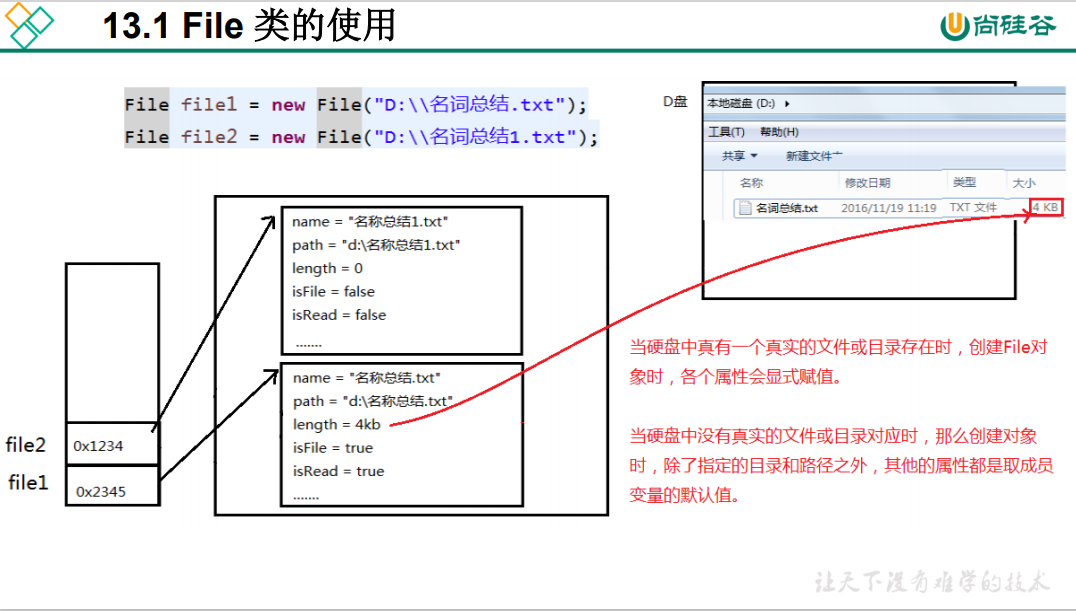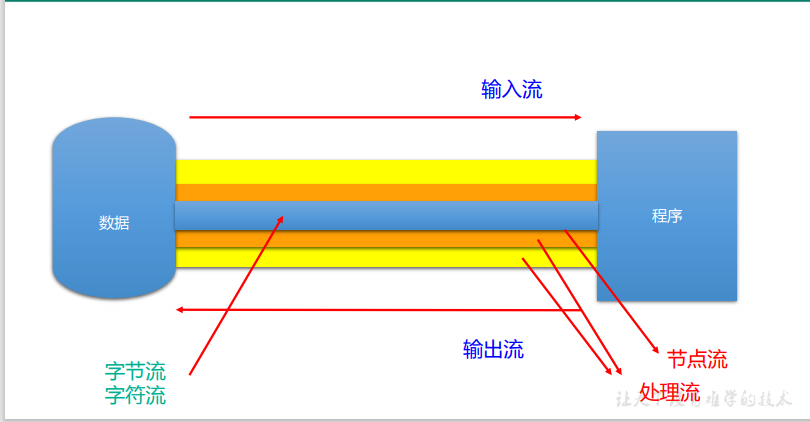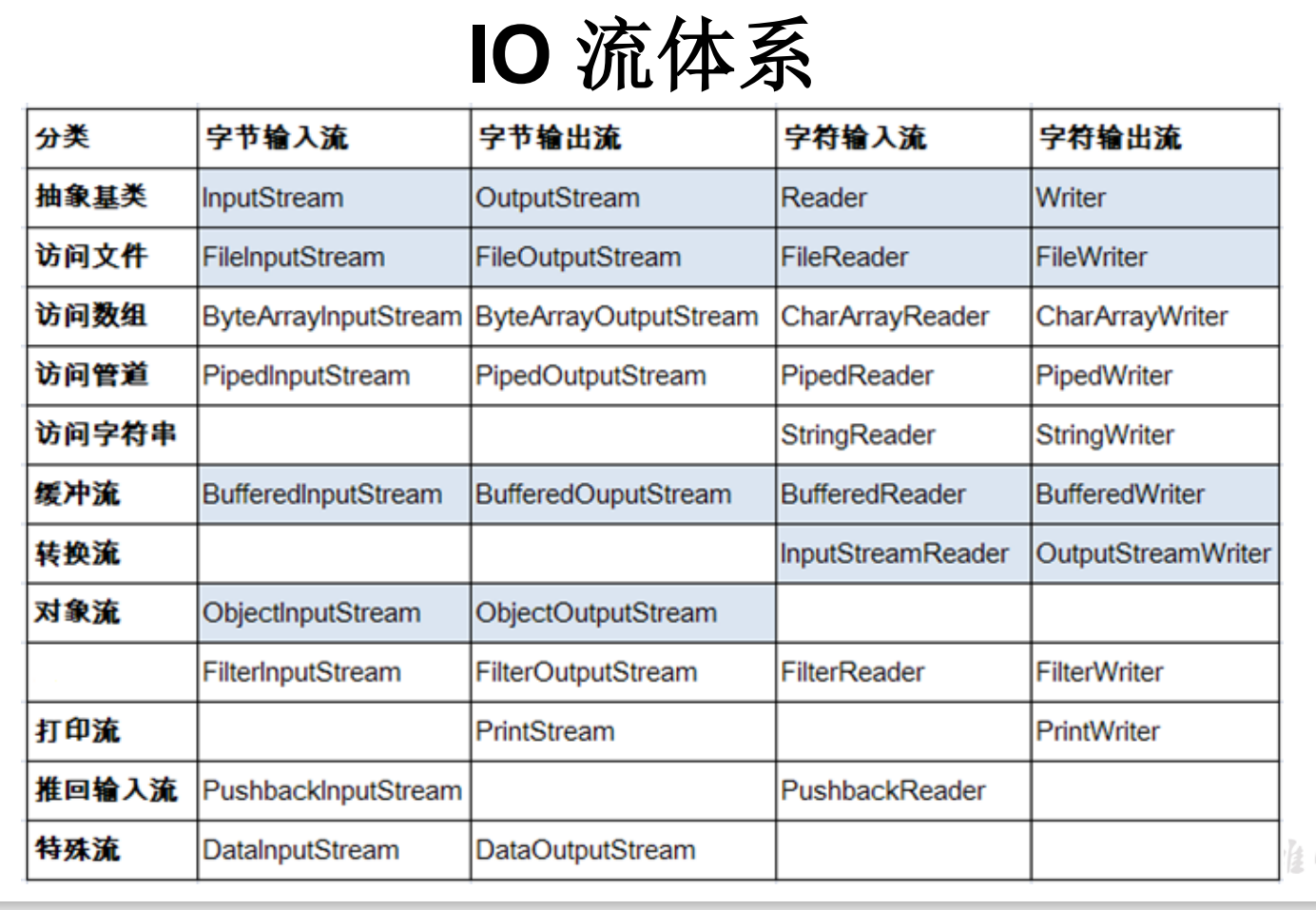java IO流
1. File类的使用
File类的一个对象,代表一个文件或一个文件目录(俗称:文件夹)
File类声明在java.io包下
File类中涉及到关于文件或文件目录的创建、删除、重命名、修改时间、文件大小等方法,并未涉及到写入或读取文件内容的操作。如果需要读取或写入文件内容,必须使用IO流来完成。
后续File类的对象常会作为参数传递到流的构造器中,指明读取或写入的”终点”.

1.1. 路径分隔符
路径中的每级目录之间用一个路径分隔符隔开。
路径分隔符和系统有关:
windows和DOS系统默认使用“\”来表示
UNIX和URL使用“/”来表示
Java程序支持跨平台运行,因此路径分隔符要慎用。
为了解决这个隐患,File类提供了一个常量:
public static final String separator。根据操作系统,动态的提供分隔符。
File file1 = new File("d:\\atguigu\\info.txt");File file2 = new File("d:" + File.separator + "atguigu" + File.separator + "info.txt");File file3 = new File("d:/atguigu");
1.2. 创建File实例的方式
/*1.如何创建File类的实例File(String filePath)File(String parentPath,String childPath)File(File parentFile,String childPath)2.相对路径:相较于某个路径下,指明的路径。绝对路径:包含盘符在内的文件或文件目录的路径3.路径分隔符windows:\\unix:/*/@Testpublic void test1(){//构造器1File file1 = new File("hello.txt");//如果是在单元测试中测试是相对于当前module,如果是在main方法中测试是相对于当前moduleFile file2 = new File("D:\\workspace_idea1\\JavaSenior\\day08\\he.txt");System.out.println(file1);System.out.println(file2);//构造器2:File file3 = new File("D:\\workspace_idea1","JavaSenior");System.out.println(file3);//构造器3:File file4 = new File(file3,"hi.txt");System.out.println(file4);}
说明:
IDEA中:
如果大家开发使用JUnit中的单元测试方法测试,相对路径即为当前的Module中
如果大家使用main()测试,相对路径即为当前的Project下。
Eclipse中
不管使用单元测试方法还是使用main方法测试,相对路径都是当前的Project下
1.3. File类常用方法
1.3.1. File类的获取功能
/*public String getAbsolutePath():获取绝对路径public String getPath() :获取路径public String getName() :获取名称public String getParent():获取上层文件目录路径。若无,返回nullpublic long length() :获取文件长度(即:字节数)。不能获取目录的长度。public long lastModified() :获取最后一次的修改时间,毫秒值如下的两个方法适用于文件目录:public String[] list() :获取指定目录下的所有文件或者文件目录的名称数组public File[] listFiles() :获取指定目录下的所有文件或者文件目录的File数组*/@Testpublic void test2(){File file1 = new File("hello.txt");File file2 = new File("d:\\io\\hi.txt");System.out.println(file1.getAbsolutePath());System.out.println(file1.getPath());System.out.println(file1.getName());System.out.println(file1.getParent());System.out.println(file1.length());System.out.println(new Date(file1.lastModified()));System.out.println();System.out.println(file2.getAbsolutePath());System.out.println(file2.getPath());System.out.println(file2.getName());System.out.println(file2.getParent());System.out.println(file2.length());System.out.println(file2.lastModified());}@Testpublic void test3(){File file = new File("D:\\workspace_idea1\\JavaSenior");String[] list = file.list();for(String s : list){System.out.println(s);}System.out.println();File[] files = file.listFiles();for(File f : files){System.out.println(f);}}
1.3.2. File类的重命名功能
/*public boolean renameTo(File dest):把文件重命名为指定的文件路径比如:file1.renameTo(file2)为例:要想保证返回true,需要file1在硬盘中是存在的,且file2不能在硬盘中存在。*/@Testpublic void test4(){File file1 = new File("hello.txt");File file2 = new File("D:\\io\\hi.txt");boolean renameTo = file2.renameTo(file1);System.out.println(renameTo);}
1.3.3. File类的判断功能
/*public boolean isDirectory():判断是否是文件目录public boolean isFile() :判断是否是文件public boolean exists() :判断是否存在public boolean canRead() :判断是否可读public boolean canWrite() :判断是否可写public boolean isHidden() :判断是否隐藏*/@Testpublic void test5(){File file1 = new File("hello.txt");file1 = new File("hello1.txt");System.out.println(file1.isDirectory());System.out.println(file1.isFile());System.out.println(file1.exists());System.out.println(file1.canRead());System.out.println(file1.canWrite());System.out.println(file1.isHidden());System.out.println();File file2 = new File("d:\\io");file2 = new File("d:\\io1");System.out.println(file2.isDirectory());System.out.println(file2.isFile());System.out.println(file2.exists());System.out.println(file2.canRead());System.out.println(file2.canWrite());System.out.println(file2.isHidden());}
1.3.4. File类的创建功能和删除功能
/*创建硬盘中对应的文件或文件目录public boolean createNewFile() :创建文件。若文件存在,则不创建,返回falsepublic boolean mkdir() :创建文件目录。如果此文件目录存在,就不创建了。如果此文件目录的上层目录不存在,也不创建。public boolean mkdirs() :创建文件目录。如果此文件目录存在,就不创建了。如果上层文件目录不存在,一并创建删除磁盘中的文件或文件目录public boolean delete():删除文件或者文件夹.如果是删除的目录下面有文件的话,则删除失败删除注意事项:Java中的删除不走回收站。*/@Testpublic void test6() throws IOException {File file1 = new File("hi.txt");if(!file1.exists()){//文件的创建file1.createNewFile();System.out.println("创建成功");}else{//文件存在file1.delete();System.out.println("删除成功");}}@Testpublic void test7(){//文件目录的创建File file1 = new File("d:\\io\\io1\\io3");boolean mkdir = file1.mkdir();if(mkdir){System.out.println("创建成功1");}File file2 = new File("d:\\io\\io1\\io4");boolean mkdir1 = file2.mkdirs();if(mkdir1){System.out.println("创建成功2");}//要想删除成功,io4文件目录下不能有子目录或文件File file3 = new File("D:\\io\\io1\\io4");file3 = new File("D:\\io\\io1");System.out.println(file3.delete());}
2. IO流原理及流的分类
I/O是Input/Output的缩写, I/O技术是非常实用的技术,用于 处理设备之间的数据传输。如读/写文件,网络通讯等。
Java程序中,对于数据的输入/输出操作以“流(stream)” 的 方式进行。
输入input:读取外部数据(磁 盘、光盘等存储设备的数据)到 程序(内存)中。
输出output:将程序(内存) 数据输出到磁盘、光盘等存储设 备中。
2.1. 流的分类
按操作数据单位不同分为:字节流(8 bit),字符流(16 bit)
按数据流的流向不同分为:输入流,输出流
按流的角色的不同分为:节点流,处理流
| (抽象基类) | 字节流 | 字符流 |
|---|---|---|
| 输入流 | InputStream | Reader |
| 输出流 | OutputStream | Writer |

2.2. I/O流体系结构

抽象基类 节点流(或文件流) 缓冲流(处理流的一种)
InputStream FileInputStream (read(byte[] buffer)) BufferedInputStream (read(byte[] buffer))
OutputStream FileOutputStream (write(byte[] buffer,0,len) BufferedOutputStream (write(byte[] buffer,0,len) / flush()
Reader FileReader (read(char[] cbuf)) BufferedReader (read(char[] cbuf) / readLine())
Writer FileWriter (write(char[] cbuf,0,len) BufferedWriter (write(char[] cbuf,0,len) / flush()
3. 节点流(或文件流)
3.1. FileReader的使用
public class FileReaderWriterTest {public static void main(String[] args) {File file = new File("hello.txt");//相较于当前工程System.out.println(file.getAbsolutePath());File file1 = new File("day09\\hello.txt");System.out.println(file1.getAbsolutePath());}/*将day09下的hello.txt文件内容读入程序中,并输出到控制台说明点:1. read()的理解:返回读入的一个字符。如果达到文件末尾,返回-12. 异常的处理:为了保证流资源一定可以执行关闭操作。需要使用try-catch-finally处理3. 读入的文件一定要存在,否则就会报FileNotFoundException。*/@Testpublic void testFileReader(){FileReader fr = null;try {//1.实例化File类的对象,指明要操作的文件File file = new File("hello.txt");//相较于当前Module//2.提供具体的流fr = new FileReader(file);//3.数据的读入//read():返回读入的一个字符。如果达到文件末尾,返回-1//方式一:// int data = fr.read();// while(data != -1){// System.out.print((char)data);// data = fr.read();// }//方式二:语法上针对于方式一的修改int data;while((data = fr.read()) != -1){System.out.print((char)data);}} catch (IOException e) {e.printStackTrace();} finally {//4.流的关闭操作// try {// if(fr != null)// fr.close();// } catch (IOException e) {// e.printStackTrace();// }//或if(fr != null){try {fr.close();} catch (IOException e) {e.printStackTrace();}}}}
3.2. 对read()方法的操作升级:使用重载方法
//对read()操作升级:使用read的重载方法@Testpublic void testFileReader1() {FileReader fr = null;try {//1.File类的实例化File file = new File("hello.txt");//2.FileReader流的实例化fr = new FileReader(file);//3.读入的操作//read(char[] cbuf):返回每次读入cbuf数组中的字符的个数。如果达到文件末尾,返回-1char[] cbuf = new char[5];int len;while((len = fr.read(cbuf)) != -1){//方式一://错误的写法// for(int i = 0;i < cbuf.length;i++){// System.out.print(cbuf[i]);// }//正确的写法// for(int i = 0;i < len;i++){// System.out.print(cbuf[i]);// }//方式二://错误的写法,对应着方式一的错误的写法// String str = new String(cbuf);// System.out.print(str);//正确的写法String str = new String(cbuf,0,len);System.out.print(str);}} catch (IOException e) {e.printStackTrace();} finally {if(fr != null){//4.资源的关闭try {fr.close();} catch (IOException e) {e.printStackTrace();}}}}
3.3. FileWriter的使用
/*从内存中写出数据到硬盘的文件里。说明:1. 输出操作,对应的File可以不存在的。并不会报异常2.File对应的硬盘中的文件如果不存在,在输出的过程中,会自动创建此文件。File对应的硬盘中的文件如果存在:如果流使用的构造器是:FileWriter(file,false) / FileWriter(file):对原有文件的覆盖如果流使用的构造器是:FileWriter(file,true):不会对原有文件覆盖,而是在原有文件基础上追加内容*/@Testpublic void testFileWriter() {FileWriter fw = null;try {//1.提供File类的对象,指明写出到的文件File file = new File("hello1.txt");//2.提供FileWriter的对象,用于数据的写出fw = new FileWriter(file,false);//3.写出的操作fw.write("I have a dream!\n");fw.write("you need to have a dream!");} catch (IOException e) {e.printStackTrace();} finally {//4.流资源的关闭if(fw != null){try {fw.close();} catch (IOException e) {e.printStackTrace();}}}}
3.4. 使用FileReader和FileWriter实现文本文件的复制
@Testpublic void testFileReaderFileWriter() {FileReader fr = null;FileWriter fw = null;try {//1.创建File类的对象,指明读入和写出的文件File srcFile = new File("hello.txt");File destFile = new File("hello2.txt");//不能使用字符流来处理图片等字节数据// File srcFile = new File("爱情与友情.jpg");// File destFile = new File("爱情与友情1.jpg");//2.创建输入流和输出流的对象fr = new FileReader(srcFile);fw = new FileWriter(destFile);//3.数据的读入和写出操作char[] cbuf = new char[5];int len;//记录每次读入到cbuf数组中的字符的个数while((len = fr.read(cbuf)) != -1){//每次写出len个字符fw.write(cbuf,0,len);}} catch (IOException e) {e.printStackTrace();} finally {//4.关闭流资源//方式一:// try {// if(fw != null)// fw.close();// } catch (IOException e) {// e.printStackTrace();// }finally{// try {// if(fr != null)// fr.close();// } catch (IOException e) {// e.printStackTrace();// }// }//方式二:try {if(fw != null)fw.close();} catch (IOException e) {e.printStackTrace();}try {if(fr != null)fr.close();} catch (IOException e) {e.printStackTrace();}}}
3.5. FileInputStream的使用
//使用字节流FileInputStream处理文本文件,可能出现乱码。@Testpublic void testFileInputStream() {FileInputStream fis = null;try {//1. 造文件File file = new File("hello.txt");//2.造流fis = new FileInputStream(file);//3.读数据byte[] buffer = new byte[5];int len;//记录每次读取的字节的个数while((len = fis.read(buffer)) != -1){String str = new String(buffer,0,len);System.out.print(str);}} catch (IOException e) {e.printStackTrace();} finally {if(fis != null){//4.关闭资源try {fis.close();} catch (IOException e) {e.printStackTrace();}}}}
结论:
对于文本文件(.txt,.java,.c,.cpp),使用字符流处理
对于非文本文件(.jpg,.mp3,.mp4,.avi,.doc,.ppt,…),使用字节流处理
3.6. 使用FileOutputStream和FileInputStream读写非文本文件
/*实现对图片的复制操作*/@Testpublic void testFileInputOutputStream() {FileInputStream fis = null;FileOutputStream fos = null;try {//File srcFile = new File("爱情与友情.jpg");File destFile = new File("爱情与友情2.jpg");//fis = new FileInputStream(srcFile);fos = new FileOutputStream(destFile);//复制的过程byte[] buffer = new byte[5];int len;while((len = fis.read(buffer)) != -1){fos.write(buffer,0,len);}} catch (IOException e) {e.printStackTrace();} finally {if(fos != null){//try {fos.close();} catch (IOException e) {e.printStackTrace();}}if(fis != null){try {fis.close();} catch (IOException e) {e.printStackTrace();}}}}
3.7. 使用FileInputStream和FileOutputStream复制文件的方法测试
//指定路径下文件的复制public void copyFile(String srcPath,String destPath){FileInputStream fis = null;FileOutputStream fos = null;try {//File srcFile = new File(srcPath);File destFile = new File(destPath);//fis = new FileInputStream(srcFile);fos = new FileOutputStream(destFile);//复制的过程byte[] buffer = new byte[1024];int len;while((len = fis.read(buffer)) != -1){fos.write(buffer,0,len);}} catch (IOException e) {e.printStackTrace();} finally {if(fos != null){//try {fos.close();} catch (IOException e) {e.printStackTrace();}}if(fis != null){try {fis.close();} catch (IOException e) {e.printStackTrace();}}}}@Testpublic void testCopyFile(){long start = System.currentTimeMillis();String srcPath = "C:\\Users\\Administrator\\Desktop\\01-视频.avi";String destPath = "C:\\Users\\Administrator\\Desktop\\02-视频.avi";//如果使用字节流处理文本文件,在控制台打印可能会出现乱码,但是如果不放在内存层面输出,直接复制到硬盘不会出现乱码// String srcPath = "hello.txt";// String destPath = "hello3.txt";copyFile(srcPath,destPath);long end = System.currentTimeMillis();System.out.println("复制操作花费的时间为:" + (end - start));//618}
4. 缓冲流
缓冲流:
BufferedInputStream
BufferedOutputStream
BufferedReader
BufferedWriter作用:
提升流的读取、写入的速度
提高读写速度的原因:内部提供了一个缓冲区。默认情况是8kb。处理流
就是“套接”在已有的流的基础上。
4.1. BufferedInputStream和BufferedOutputStream的基本使用
/*实现非文本文件的复制*/@Testpublic void BufferedStreamTest() throws FileNotFoundException {BufferedInputStream bis = null;BufferedOutputStream bos = null;try {//1.造文件File srcFile = new File("爱情与友情.jpg");File destFile = new File("爱情与友情3.jpg");//2.造流//2.1 造节点流FileInputStream fis = new FileInputStream((srcFile));FileOutputStream fos = new FileOutputStream(destFile);//2.2 造缓冲流bis = new BufferedInputStream(fis);bos = new BufferedOutputStream(fos);//3.复制的细节:读取、写入byte[] buffer = new byte[10];int len;while((len = bis.read(buffer)) != -1){bos.write(buffer,0,len);// bos.flush();//刷新缓冲区}} catch (IOException e) {e.printStackTrace();} finally {//4.资源关闭//要求:先关闭外层的流,再关闭内层的流if(bos != null){try {bos.close();} catch (IOException e) {e.printStackTrace();}}if(bis != null){try {bis.close();} catch (IOException e) {e.printStackTrace();}}//说明:关闭外层流的同时,内层流也会自动的进行关闭。关于内层流的关闭,我们可以省略.// fos.close();// fis.close();}
4.2. 缓冲流与节点流读写速度对比
//实现文件复制的方法public void copyFileWithBuffered(String srcPath,String destPath){BufferedInputStream bis = null;BufferedOutputStream bos = null;try {//1.造文件File srcFile = new File(srcPath);File destFile = new File(destPath);//2.造流//2.1 造节点流FileInputStream fis = new FileInputStream((srcFile));FileOutputStream fos = new FileOutputStream(destFile);//2.2 造缓冲流bis = new BufferedInputStream(fis);bos = new BufferedOutputStream(fos);//3.复制的细节:读取、写入byte[] buffer = new byte[1024];int len;while((len = bis.read(buffer)) != -1){bos.write(buffer,0,len);}} catch (IOException e) {e.printStackTrace();} finally {//4.资源关闭//要求:先关闭外层的流,再关闭内层的流if(bos != null){try {bos.close();} catch (IOException e) {e.printStackTrace();}}if(bis != null){try {bis.close();} catch (IOException e) {e.printStackTrace();}}//说明:关闭外层流的同时,内层流也会自动的进行关闭。关于内层流的关闭,我们可以省略.// fos.close();// fis.close();}}@Testpublic void testCopyFileWithBuffered(){long start = System.currentTimeMillis();String srcPath = "C:\\Users\\Administrator\\Desktop\\01-视频.avi";String destPath = "C:\\Users\\Administrator\\Desktop\\03-视频.avi";copyFileWithBuffered(srcPath,destPath);long end = System.currentTimeMillis();System.out.println("复制操作花费的时间为:" + (end - start));//618 - 176}
4.3. BufferedReader和BufferedWriter基本使用
/*使用BufferedReader和BufferedWriter实现文本文件的复制*/@Testpublic void testBufferedReaderBufferedWriter(){BufferedReader br = null;BufferedWriter bw = null;try {//创建文件和相应的流br = new BufferedReader(new FileReader(new File("dbcp.txt")));bw = new BufferedWriter(new FileWriter(new File("dbcp1.txt")));//读写操作//方式一:使用char[]数组// char[] cbuf = new char[1024];// int len;// while((len = br.read(cbuf)) != -1){// bw.write(cbuf,0,len);// // bw.flush();// }//方式二:使用StringString data;while((data = br.readLine()) != null){//方法一:// bw.write(data + "\n");//data中不包含换行符//方法二:bw.write(data);//data中不包含换行符bw.newLine();//提供换行的操作}} catch (IOException e) {e.printStackTrace();} finally {//关闭资源if(bw != null){try {bw.close();} catch (IOException e) {e.printStackTrace();}}if(br != null){try {br.close();} catch (IOException e) {e.printStackTrace();}}}}
4.4. 练习题
一:图片的加密和解密
/*** @author shkstart* @create 2019 下午 4:08*/public class PicTest {//图片的加密@Testpublic void test1() {FileInputStream fis = null;FileOutputStream fos = null;try {fis = new FileInputStream("爱情与友情.jpg");fos = new FileOutputStream("爱情与友情secret.jpg");byte[] buffer = new byte[20];int len;while ((len = fis.read(buffer)) != -1) {//字节数组进行修改//错误的// for(byte b : buffer){// b = (byte) (b ^ 5);// }//正确的for (int i = 0; i < len; i++) {buffer[i] = (byte) (buffer[i] ^ 5);}fos.write(buffer, 0, len);}} catch (IOException e) {e.printStackTrace();} finally {if (fos != null) {try {fos.close();} catch (IOException e) {e.printStackTrace();}}if (fis != null) {try {fis.close();} catch (IOException e) {e.printStackTrace();}}}}//图片的解密@Testpublic void test2() {FileInputStream fis = null;FileOutputStream fos = null;try {fis = new FileInputStream("爱情与友情secret.jpg");fos = new FileOutputStream("爱情与友情4.jpg");byte[] buffer = new byte[20];int len;while ((len = fis.read(buffer)) != -1) {//字节数组进行修改//错误的// for(byte b : buffer){// b = (byte) (b ^ 5);// }//正确的for (int i = 0; i < len; i++) {buffer[i] = (byte) (buffer[i] ^ 5);}fos.write(buffer, 0, len);}} catch (IOException e) {e.printStackTrace();} finally {if (fos != null) {try {fos.close();} catch (IOException e) {e.printStackTrace();}}if (fis != null) {try {fis.close();} catch (IOException e) {e.printStackTrace();}}}}}
二:获取文本上每个字符出现的次数:提示:遍历文本的每一个字符;字符及出现的次数保存在Map中;将Map中数据 写入文件
5. 转换流
处理流之二:转换流的使用
转换流:属于字符流
InputStreamReader:将一个字节的输入流转换为字符的输入流
OutputStreamWriter:将一个字符的输出流转换为字节的输出流作用:提供字节流与字符流之间的转换
解码:字节、字节数组 —->字符数组、字符串
编码:字符数组、字符串 —-> 字节、字节数组。编码决定了解码的方式。
字符集
ASCII:美国标准信息交换码。
用一个字节的7位可以表示。
ISO8859-1:拉丁码表。欧洲码表
用一个字节的8位表示。
GB2312:中国的中文编码表。最多两个字节编码所有字符
GBK:中国的中文编码表升级,融合了更多的中文文字符号。最多两个字节编码
Unicode:国际标准码,融合了目前人类使用的所有字符。为每个字符分配唯一的字符码。所有的文字都用两个字节来表示。
UTF-8:变长的编码方式,可用1-4个字节来表示一个字符。
5.1. 字节的输入流到字符的输入流的转换
/*此时处理异常的话,仍然应该使用try-catch-finallyInputStreamReader的使用,实现字节的输入流到字符的输入流的转换*/@Testpublic void test1() throws IOException {FileInputStream fis = new FileInputStream("dbcp.txt");// InputStreamReader isr = new InputStreamReader(fis);//使用系统默认的字符集//参数2指明了字符集,具体使用哪个字符集,取决于文件dbcp.txt保存时使用的字符集InputStreamReader isr = new InputStreamReader(fis,"UTF-8");//使用系统默认的字符集char[] cbuf = new char[20];int len;while((len = isr.read(cbuf)) != -1){String str = new String(cbuf,0,len);System.out.print(str);}isr.close();}
5.2. 综合使用InputStreamReader和OutputStreamWriter
/*此时处理异常的话,仍然应该使用try-catch-finally综合使用InputStreamReader和OutputStreamWriter*/@Testpublic void test2() throws Exception {//1.造文件、造流File file1 = new File("dbcp.txt");File file2 = new File("dbcp_gbk.txt");FileInputStream fis = new FileInputStream(file1);FileOutputStream fos = new FileOutputStream(file2);InputStreamReader isr = new InputStreamReader(fis,"utf-8");OutputStreamWriter osw = new OutputStreamWriter(fos,"gbk");//2.读写过程char[] cbuf = new char[20];int len;while((len = isr.read(cbuf)) != -1){osw.write(cbuf,0,len);}//3.一定关闭资源,不然写不进去,写进去没有内容isr.close();osw.close();}
6. 标准输入、输出流(了解)
标准的输入、输出流,必须要放在main方法中,单元测试控制台不能输入字符。
System.in:标准的输入流,默认从键盘输入。System.in的类型是InputStream
System.out:标准的输出流,默认从控制台输出。System.out的类型是PrintStream,其是OutputStream的子类 FilterOutputStream 的子类。
重定向:通过System类的setIn,setOut方法对默认设备进行改变。
public static void setIn(InputStream in)
public static void setOut(PrintStream out)
6.1. 练习
从键盘输入字符串,要求将读取到的整行字符串转成大写输出。然后继续 进行输入操作,直至当输入“e”或者“exit”时,退出程序。
/*1.标准的输入、输出流1.1System.in:标准的输入流,默认从键盘输入System.out:标准的输出流,默认从控制台输出1.2System类的setIn(InputStream is) / setOut(PrintStream ps)方式重新指定输入和输出的流。1.3练习:从键盘输入字符串,要求将读取到的整行字符串转成大写输出。然后继续进行输入操作,直至当输入“e”或者“exit”时,退出程序。方法一:使用Scanner实现,调用next()返回一个字符串方法二:使用System.in实现。System.in ---> 转换流 ---> BufferedReader的readLine()*/public static void main(String[] args) {BufferedReader br = null;try {InputStreamReader isr = new InputStreamReader(System.in);br = new BufferedReader(isr);while (true) {System.out.println("请输入字符串:");String data = br.readLine();if ("e".equalsIgnoreCase(data) || "exit".equalsIgnoreCase(data)) {System.out.println("程序结束");break;}String upperCase = data.toUpperCase();System.out.println(upperCase);}} catch (IOException e) {e.printStackTrace();} finally {if (br != null) {try {br.close();} catch (IOException e) {e.printStackTrace();}}}}
7. 打印流(了解)
打印流:PrintStream和PrintWriter
提供了一系列重载的print()和println()方法,用于多种数据类型的输出
System.out返回的是PrintStream的实例
/*2. 打印流:PrintStream 和PrintWriter2.1 提供了一系列重载的print() 和 println()2.2 练习:*/@Testpublic void test2() {PrintStream ps = null;try {FileOutputStream fos = new FileOutputStream(new File("D:\\IO\\text.txt"));// 创建打印输出流,设置为自动刷新模式(写入换行符或字节 '\n' 时都会刷新输出缓冲区)ps = new PrintStream(fos, true);if (ps != null) {// 把标准输出流(控制台输出)改成文件System.setOut(ps);}for (int i = 0; i <= 255; i++) { // 输出ASCII字符System.out.print((char) i);if (i % 50 == 0) { // 每50个数据一行System.out.println(); // 换行}}} catch (FileNotFoundException e) {e.printStackTrace();} finally {if (ps != null) {ps.close();}}}
8. 数据流(了解)
DataInputStream 和 DataOutputStream
作用:用于读取或写出基本数据类型的变量或字符串
/*3. 数据流3.1 DataInputStream 和 DataOutputStream3.2 作用:用于读取或写出基本数据类型的变量或字符串练习:将内存中的字符串、基本数据类型的变量写出到文件中。注意:处理异常的话,仍然应该使用try-catch-finally.*/@Testpublic void test3() throws IOException {//1.DataOutputStream dos = new DataOutputStream(new FileOutputStream("data.txt"));//2.dos.writeUTF("刘建辰");dos.flush();//刷新操作,将内存中的数据写入文件dos.writeInt(23);dos.flush();dos.writeBoolean(true);dos.flush();//3.dos.close();}/*将文件中存储的基本数据类型变量和字符串读取到内存中,保存在变量中。注意点:读取不同类型的数据的顺序要与当初写入文件时,保存的数据的顺序一致!*/@Testpublic void test4() throws IOException {//1.DataInputStream dis = new DataInputStream(new FileInputStream("data.txt"));//2.String name = dis.readUTF();int age = dis.readInt();boolean isMale = dis.readBoolean();System.out.println("name = " + name);System.out.println("age = " + age);System.out.println("isMale = " + isMale);//3.dis.close();}
9. 对象流
9.1. 对象的序列化
对象序列化机制允许把内存中的Java对象转换成平台无关的二进制流,从而允许把这种二进制流持久地保存在磁盘上,或通过网络将这种二进制流传 输到另一个网络节点。//当其它程序获取了这种二进制流,就可以恢复成原来的Java对象。面试题
9.2. 对象流的使用
ObjectInputStream和OjbectOutputSteam
作用:用于存储和读取基本数据类型数据或对象的处理流。它的强大之处就是可以把Java中的对象写入到数据源中,也能把对象从数据源中还原回来。
序列化过程:将内存中的java对象保存到磁盘中或通过网络传输出去。使用ObjectOutputStream实现
/*序列化过程:将内存中的java对象保存到磁盘中或通过网络传输出去使用ObjectOutputStream实现*/@Testpublic void testObjectOutputStream(){ObjectOutputStream oos = null;try {//1.oos = new ObjectOutputStream(new FileOutputStream("object.dat"));//2.oos.writeObject(new String("我爱北京天安门"));oos.flush();//刷新操作oos.writeObject(new Person("王铭",23));oos.flush();oos.writeObject(new Person("张学良",23,1001,new Account(5000)));oos.flush();} catch (IOException e) {e.printStackTrace();} finally {if(oos != null){//3.try {oos.close();} catch (IOException e) {e.printStackTrace();}}}}
反序列化:将磁盘文件中的对象还原为内存中的一个java对象。使用ObjectInputStream来实现
/*反序列化:将磁盘文件中的对象还原为内存中的一个java对象使用ObjectInputStream来实现*/@Testpublic void testObjectInputStream(){ObjectInputStream ois = null;try {ois = new ObjectInputStream(new FileInputStream("object.dat"));Object obj = ois.readObject();String str = (String) obj;Person p = (Person) ois.readObject();Person p1 = (Person) ois.readObject();System.out.println(str);System.out.println(p);System.out.println(p1);} catch (IOException e) {e.printStackTrace();} catch (ClassNotFoundException e) {e.printStackTrace();} finally {if(ois != null){try {ois.close();} catch (IOException e) {e.printStackTrace();}}}}
9.3. 自定义类实现序列化与反序列化操作
9.3.1. serialVersionUID的理解
凡是实现Serializable接口的类都有一个表示序列化版本标识符的静态变量:
private static final long serialVersionUID;
serialVersionUID用来表明类的不同版本间的兼容性。简言之,其目的是以序列化对象 进行版本控制,有关各版本反序列化时是否兼容。
如果类没有显示定义这个静态常量,它的值是Java运行时环境根据类的内部细节自 动生成的。若类的实例变量做了修改,serialVersionUID 可能发生变化。故建议, 显式声明。
简单来说,Java的序列化机制是通过在运行时判断类的serialVersionUID来验 证版本一致性的。在进行反序列化时,JVM会把传来的字节流中的 serialVersionUID与本地相应实体类的serialVersionUID进行比较,如果相同 就认为是一致的,可以进行反序列化,否则就会出现序列化版本不一致的异常。(InvalidCastException)
9.3.2. 对象可序列化的要求
要想一个java对象是可序列化的,需要满足相应的要求。
需要实现接口:Serializable
当前类提供一个全局常量:serialVersionUID
除了当前Person类需要实现Serializable接口之外,还必须保证其内部所有属性也必须是可序列化的。(默认情况下,基本数据类型可序列化)
补充:ObjectOutputStream和ObjectInputStream不能序列化static和transient修饰的成员变量
/*** Person需要满足如下的要求,方可序列化* 1.需要实现接口:Serializable* 2.当前类提供一个全局常量:serialVersionUID* 3.除了当前Person类需要实现Serializable接口之外,还必须保证其内部所有属性* 也必须是可序列化的。(默认情况下,基本数据类型可序列化)*** 补充:ObjectOutputStream和ObjectInputStream不能序列化static和transient修饰的成员变量*** @author shkstart* @create 2019 上午 10:38*/public class Person implements Serializable{public static final long serialVersionUID = 475463534532L;private String name;private int age;private int id;private Account acct;public Person(String name, int age, int id) {this.name = name;this.age = age;this.id = id;}public Person(String name, int age, int id, Account acct) {this.name = name;this.age = age;this.id = id;this.acct = acct;}@Overridepublic String toString() {return "Person{" +"name='" + name + '\'' +", age=" + age +", id=" + id +", acct=" + acct +'}';}public int getId() {return id;}public void setId(int id) {this.id = id;}public String getName() {return name;}public void setName(String name) {this.name = name;}public int getAge() {return age;}public void setAge(int age) {this.age = age;}public Person(String name, int age) {this.name = name;this.age = age;}public Person() {}}class Account implements Serializable{public static final long serialVersionUID = 4754534532L;private double balance;@Overridepublic String toString() {return "Account{" +"balance=" + balance +'}';}public double getBalance() {return balance;}public void setBalance(double balance) {this.balance = balance;}public Account(double balance) {this.balance = balance;}}
10. 随机存取文件流RandomAccessFile
RandomAccessFile 类
RandomAccessFile直接继承于java.lang.Object类,实现了DataInput和DataOutput接口
RandomAccessFile既可以作为一个输入流,又可以作为一个输出流
10.1. RandomAccessFile实现数据的读写操作
如果RandomAccessFile作为输出流时,写出到的文件如果不存在,则在执行过程中自动创建。
如果写出到的文件存在,则会对原有文件内容进行覆盖。(默认情况下,从头覆盖)
@Testpublic void test1() {RandomAccessFile raf1 = null;RandomAccessFile raf2 = null;try {//1.raf1 = new RandomAccessFile(new File("爱情与友情.jpg"),"r");raf2 = new RandomAccessFile(new File("爱情与友情1.jpg"),"rw");//2.byte[] buffer = new byte[1024];int len;while((len = raf1.read(buffer)) != -1){raf2.write(buffer,0,len);}} catch (IOException e) {e.printStackTrace();} finally {//3.if(raf1 != null){try {raf1.close();} catch (IOException e) {e.printStackTrace();}}if(raf2 != null){try {raf2.close();} catch (IOException e) {e.printStackTrace();}}}}@Testpublic void test2() throws IOException {RandomAccessFile raf1 = new RandomAccessFile("hello.txt","rw");raf1.seek(3);//将指针调到角标为3的位置raf1.write("xyz".getBytes());//raf1.close();}
10.2. RandomAccessFile实现数据的插入操作
可以通过相关的操作,实现RandomAccessFile“插入”数据的效果
/*使用RandomAccessFile实现数据的插入效果*/@Testpublic void test3() throws IOException {RandomAccessFile raf1 = new RandomAccessFile("hello.txt","rw");raf1.seek(3);//将指针调到角标为3的位置//保存指针3后面的所有数据到StringBuilder中StringBuilder builder = new StringBuilder((int) new File("hello.txt").length());byte[] buffer = new byte[20];int len;while((len = raf1.read(buffer)) != -1){builder.append(new String(buffer,0,len)) ;}//调回指针,写入“xyz”raf1.seek(3);raf1.write("xyz".getBytes());//将StringBuilder中的数据写入到文件中raf1.write(builder.toString().getBytes());raf1.close();//思考:将StringBuilder替换为ByteArrayOutputStream}
11. NIO.2中Path、Paths、Files的使用(先了解)
11.1. NIO概述
Java NIO (New IO,Non-Blocking IO)是从Java 1.4版本开始引入的一套新 的IO API,可以替代标准的Java IO API。NIO与原来的IO有同样的作用和目 的,但是使用的方式完全不同,NIO支持面向缓冲区的(IO是面向流的)、基于通道的IO操作。NIO将以更加高效的方式进行文件的读写操作。
随着 JDK 7 的发布,Java对NIO进行了极大的扩展,增强了对 文件处理和文件系统特性的支持,以至于我们称他们为 NIO.2。 因为 NIO 提供的一些功能,NIO已经成为文件处理中越来越重要 的部分。
11.2. Path、Paths、Files类
早期的Java只提供了一个File类来访问文件系统,但File类的功能比较有限,所 提供的方法性能也不高。而且,大多数方法在出错时仅返回失败,并不会提供异 常信息。
NIO. 2为了弥补这种不足,引入了Path接口,代表一个平台无关的平台路径,描 述了目录结构中文件的位置。Path可以看成是File类的升级版本,实际引用的资 源也可以不存在。
在以前IO操作都是这样写的:
import java.io.File;File file = new File("index.html")
但在Java7 中,我们可以这样写:
import java.nio.file.Path;import java.nio.file.Paths;Path path = Paths.get("index.html");
同时,NIO.2在java.nio.file包下还提供了Files、Paths工具类,Files包含 了大量静态的工具方法来操作文件;Paths则包含了两个返回Path的静态 工厂方法。
Paths 类提供的静态 get() 方法用来获取 Path 对象:
- static Path get(String first, String … more) : 用于将多个字符串串连成路径
- static Path get(URI uri): 返回指定uri对应的Path路径
12. 使用第三方Jar包实现数据读写
idea中导入commons-io-2.5.jar
package com.atguigu.java;import org.apache.commons.io.FileUtils;import java.io.File;import java.io.IOException;/*** @author shkstart* @create 2019 上午 11:58*/public class FileUtilsTest {public static void main(String[] args) {File srcFile = new File("day10\\爱情与友情.jpg");File destFile = new File("day10\\爱情与友情2.jpg");try {FileUtils.copyFile(srcFile,destFile);} catch (IOException e) {e.printStackTrace();}}}

